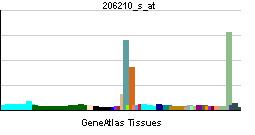Species Human Entrez 1071 | Human Mouse Ensembl ENSG00000087237 | |
 | ||
Aliases CETP, BPIFF, HDLCQ10, cholesteryl ester transfer protein External IDs OMIM: 118470 HomoloGene: 47904 GeneCards: CETP | ||
Cholesteryl ester transfer protein (CETP), also called plasma lipid transfer protein, is a plasma protein that facilitates the transport of cholesteryl esters and triglycerides between the lipoproteins. It collects triglycerides from very-low-density (VLDL) or low-density lipoproteins (LDL) and exchanges them for cholesteryl esters from high-density lipoproteins (HDL), and vice versa. Most of the time, however, CETP does a heteroexchange, trading a triglyceride for a cholesteryl ester or a cholesteryl ester for a triglyceride.
Contents
Genetics
The CETP gene is located on the sixteenth chromosome (16q21).
Role in disease
Rare mutations leading to reduced function of CETP have been linked to accelerated atherosclerosis. In contrast, a polymorphism (I405V) of the CETP gene leading to lower serum levels has also been linked to exceptional longevity and to metabolic response to nutritional intervention. However, this mutation also increases the prevalence of coronary heart disease in patients with hypertriglyceridemia. The D442G mutation, which lowers CETP levels and increases HDL levels also increases coronary heart disease.
Elaidic acid, a major component of trans fat, increases CETP activity.
Pharmacology
As HDL can alleviate atherosclerosis and other cardiovascular diseases, and certain disease states such as the metabolic syndrome feature low HDL, pharmacological inhibition of CETP is being studied as a method of improving HDL levels. To be specific, in a 2004 study, the small molecular agent torcetrapib was shown to increase HDL levels, alone and with a statin, and lower LDL when co-administered with a statin. Studies into cardiovascular endpoints, however, were largely disappointing. While they confirmed the change in lipid levels, most reported an increase in blood pressure, no change in atherosclerosis, and, in a trial of a combination of torcetrapib and atorvastatin, an increase in cardiovascular events and mortality.
A compound related to torcetrapib, Dalcetrapib (investigative name JTT-705/R1658), was also studied, but trials have ceased. It increases HDL levels by 30%, as compared to 60% by torcetrapib. Two CETP inhibitors are currently under development. One is Merck's MK-0859 anacetrapib, which in initial studies did not increase blood pressure. The other is Eli Lilly's evacetrapib, which failed in Phase 3 trials.
Interactive pathway map
Click on genes, proteins and metabolites below to link to respective articles.
